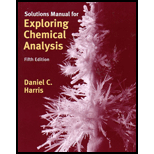
(a)
Interpretation:
Number of plates and plate height and resolution has to be calculated.
Concept Introduction:
Expression to compute number of theoretical plate is as follows:
Here,
It has been found that greater the equilibration steps narrower will be band so this suggests
Expression to compute plate height is as follows:
Here,
(a)
Explanation of Solution
Expression to compute number of theoretical plate is as follows:
Substitute
Thus, number of theoretical plate is
Expression to compute
Substitute
`
Thus, plate height is
Value of
Expression to compute resolution is as follows:
Substitute
Thus, value of resolution is 1.3.
Ratio of plate height is calculated as follows:
Reason behind such massive plate height difference is that rate of longitudinal diffusion is much more rapid in gas than in liquid chromatography.
(a)
Interpretation:
Number of plates and plate height for peak 11 and resolution for peaks 16 and 17 has to be calculated.
Concept Introduction:
Expression to compute number of theoretical plate is as follows:
Here,
It has been found that greater the equilibration steps narrower will be band so this suggests
Expression to compute plate height is as follows:
Here,
(a)
Explanation of Solution
Expression to compute number of theoretical plate is as follows:
Substitute
Thus, number of theoretical plate is
Expression to compute
Substitute
`
Thus, plate height is
Value of
Expression to compute resolution is as follows:
Substitute
Thus, value of resolution is 1.3.
(b)
Interpretation:
Extent of larger plate height has to be calculated and reason behind such massive plate height difference has to be calculated.
Concept Introduction:
Refer to part (a).
(b)
Explanation of Solution
Ratio of plate height is calculated as follows:
Reason behind such massive plate height difference is that rate of longitudinal diffusion is much more rapid in gas than in liquid chromatography.
Want to see more full solutions like this?
Chapter 22 Solutions
Solutions Manual for Exploring Chemical Analysis
 ChemistryChemistryISBN:9781305957404Author:Steven S. Zumdahl, Susan A. Zumdahl, Donald J. DeCostePublisher:Cengage Learning
ChemistryChemistryISBN:9781305957404Author:Steven S. Zumdahl, Susan A. Zumdahl, Donald J. DeCostePublisher:Cengage Learning ChemistryChemistryISBN:9781259911156Author:Raymond Chang Dr., Jason Overby ProfessorPublisher:McGraw-Hill Education
ChemistryChemistryISBN:9781259911156Author:Raymond Chang Dr., Jason Overby ProfessorPublisher:McGraw-Hill Education Principles of Instrumental AnalysisChemistryISBN:9781305577213Author:Douglas A. Skoog, F. James Holler, Stanley R. CrouchPublisher:Cengage Learning
Principles of Instrumental AnalysisChemistryISBN:9781305577213Author:Douglas A. Skoog, F. James Holler, Stanley R. CrouchPublisher:Cengage Learning Organic ChemistryChemistryISBN:9780078021558Author:Janice Gorzynski Smith Dr.Publisher:McGraw-Hill Education
Organic ChemistryChemistryISBN:9780078021558Author:Janice Gorzynski Smith Dr.Publisher:McGraw-Hill Education Chemistry: Principles and ReactionsChemistryISBN:9781305079373Author:William L. Masterton, Cecile N. HurleyPublisher:Cengage Learning
Chemistry: Principles and ReactionsChemistryISBN:9781305079373Author:William L. Masterton, Cecile N. HurleyPublisher:Cengage Learning Elementary Principles of Chemical Processes, Bind...ChemistryISBN:9781118431221Author:Richard M. Felder, Ronald W. Rousseau, Lisa G. BullardPublisher:WILEY
Elementary Principles of Chemical Processes, Bind...ChemistryISBN:9781118431221Author:Richard M. Felder, Ronald W. Rousseau, Lisa G. BullardPublisher:WILEY





